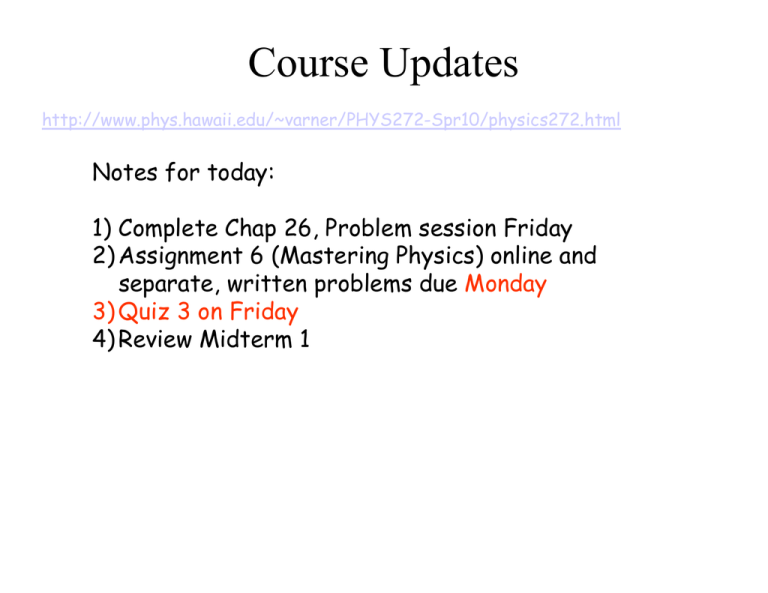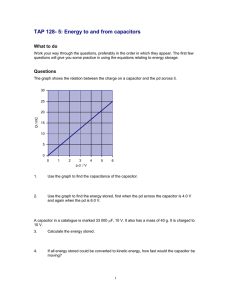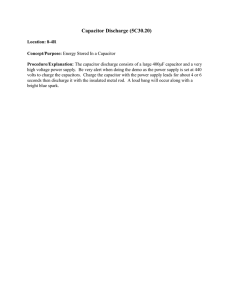Lecture 16
advertisement

Course Updates http://www.phys.hawaii.edu/~varner/PHYS272-Spr10/physics272.html Notes for today: 1) Complete Chap 26, Problem session Friday 2) Assignment 6 (Mastering Physics) online and separate, written problems due Monday 3) Quiz 3 on Friday 4) Review Midterm 1 Kirchhoff’s Rules Kirchhoff’s rules are statements used to solve for currents and voltages in complicated circuits. The rules are Rule I. Sum of currents into any junction is zero. ∑ Ii = 0 i I1 + I 2 = I12 Why? Since charge is conserved. Rule II. Sum of potential differences in any loop is zero. (This includes emfs) a ∑Vi = 0 i Why? Since potential (energy) is conserved d b c Vab + Vbc + Vcd + Vda = 0 RC Circuits I a I a I I R C ε Cε R b b RC + + C ε 2RC Cε RC - - 2RC q = Cεe − t / RC ( q 0 q = Cε 1 − e − t / RC t ) q 0 t RC Circuits (Time-varying currents, charging) • I a Charge capacitor: I R C initially uncharged; connect switch to a at t=0 Calculate current and b C ε charge as function of time. Q ε − IR − = 0 C •Convert to differential equation for Q: • Loop theorem ⇒ dQ I= dt ⇒ Would it matter where R is placed in the loop?? dQ Q ε =R + dt C Charging Capacitor • I a Charge capacitor: I R ε=R dQ Q + dt C b C ε • Guess solution: Q = Cε (1 − e −t RC ) •Check that it is a solution: dQ = C ε e − t / RC dt ⇒ Note that this “guess” fits the boundary conditions: 1 ⎞ ⎛ − ⎜ ⎟ ⎝ RC ⎠ −t dQ Q −t / RC R + = −εe + ε (1 − e RC ) = ε dt C ! t = 0 ⇒Q = 0 t = ∞ ⇒ Q = Cε Charging Capacitor • Q = Cε (1− e −t / RC • I R ) b C ε Current is found from differentiation: dQ ε −t / RC I= = e dt R I a Charge capacitor: ⇒ Conclusion: • Capacitor reaches its final charge(Q=Cε ) exponentially with time constant τ = RC. • Current decays from max (=ε /R) with same time constant. Charging Capacitor Charge on C Q = Cε (1 − e− t / RC ) Max = Cε RC 2RC Cε Q 63% Max at t = RC 0 Current I = dQ ε − t / RC = e dt R Max = ε /R t ε /R I 37% Max at t = RC 0 t Discharging Capacitor I a dQ Q R + =0 dt C b I R C ε • Guess solution: + + Q = Q 0 e − t /τ = C ε e − t / RC • Check that it is a solution: dQ = C ε e − t / RC dt ⇒ Note that this “guess” fits the boundary conditions: 1 ⎞ ⎛ − ⎜ ⎟ ⎝ RC ⎠ dQ Q − − R dt + = − ε e t / RC + ε e t / RC = 0 C ! t = 0 ⇒ Q = Cε t =∞⇒Q=0 - - Discharging Capacitor • Discharge capacitor: Q = Q 0 e − t /τ = C ε e − t / RC • Current is found from differentiation: dQ ε −t / RC I= =− e dt R ⇒ Minus sign: Current is opposite to original definition, i.e., charges flow away from capacitor. I a b I R + + C ε - - Conclusion: • Capacitor discharges exponentially with time constant τ = RC • Current decays from initial max value (= -ε/R) with same time constant Discharging Capacitor Cε Charge on C Q = C ε e − t / RC Max = Cε RC 2RC Q 37% Max at t = RC 0 zero t 0 Current dQ ε I = = − e − t / RC dt R I “Max” = -ε/R 37% Max at t = RC -ε /R t Midterm 1 statistics B F D C A Cumulative statistics Midterm Review • Not many systematic, consistent problems • However, some recurrent themes: – – – – Electric Potential (V) vs. Potential Energy (U) Electric field sums as vector quantity Potential field (V) sums as a scaler Area of a circle is πr2 • Detailed points breakdown (by roster ID) linked from course webpage • Will go over in outline form problems next… For next time • HW #6 Assigned Æ due next Monday • Quiz #3 on Friday • Problem session Friday prior to quiz

